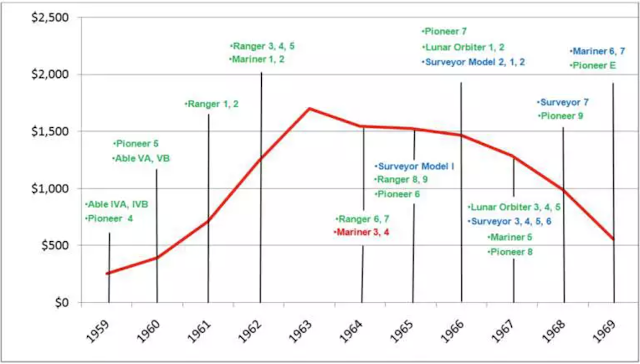_____________________________________
One of the many reasons I enjoy writing about space so much on Astronomical Returns is that there's an incredibly diverse array of space-related subfields, so I never run out of topics to explore. Since I work at SpaceX's Finance department, space finance has become my favorite and most unique specialty, but way back when I was a kid, one subject piqued my interest above all else: planetary science! The reason for this was quite simple - it's the easiest space topic for a 5 year old to grasp. Rocket science is too hard, theoretical physics and cosmology are too abstract, space history is too esoteric, etc. But learning about the solar system came naturally to me; after all, any kid with unfettered imagination and half a brain can admire the incredible photos we have of the planets, moons, and asteroids!
I suppose it's my good fortune then that I was born in the 1990s and grew up in the 2000s, a period of relative resurgence for NASA's planetary science programs. Had I grown up two decades prior, perhaps my interests would've been shaped differently, because the 1980s were unequivocally the lost decade of planetary science. In fact, between 1978 and 1989, the US didn't launch a single planetary mission. What happened??
When the Space Race began, Congress and NASA were laser focused on putting a man on the moon, but fortunately they still had the foresight to recognize that rapid developments in rocketry would also enable robotic expeditions across the solar system, and they allocated funding accordingly. With generous grants, NASA was able to attract scientists from other fields like geology and chemistry and offered them the chance to launch their instruments to space. Perhaps most crucially, the Jet Propulsion Laboratory, which had been founded through Caltech back in 1936, was transferred from the Army to NASA when NASA was established in 1958. Almost immediately, the scientific community at JPL proved themselves to be the springboard of US planetary exploration: the Mariner probes built at JPL in the 1960s and 70s became the first spacecraft to fly by Venus, Mars, and Mercury, followed soon after by the Viking landers which reached the surface of Mars, as well as the Voyager probes that flew by Uranus and Neptune and have since left our solar system! The Golden Age of planetary science seemed at hand!
 |
| The entrance to JPL in 1957, just before NASA was created |
But as the 1970s progressed and the Apollo Program ended, it became clear that NASA's budget was facing major cutbacks, and once Ronald Reagan was swept into office in 1981, small government and fiscal discipline became the rallying cry of the new administration. NASA had three priorities at the start of the 1980s: 1) complete the Space Shuttle, 2) maintain a solar system exploration program, and 3) conduct advanced aeronautical and other scientific research. Despite adamant protests from NASA officials, Congress' draconian budget proposal would have left NASA with no choice but to shut down one of these three programs. Axing the Space Shuttle was a non-starter even in the face of rapidly mounting costs due to its importance for both human spaceflight and national security, so solar system exploration was left to compete with other scientific fields like astronomy and astrophysics. All of a sudden, proposals like the Hubble Space Telescope, the Galileo spacecraft to Jupiter, a flyby of Halley's comet, and a Venusian radar-mapping mission were all on the chopping block, and NASA was seriously contemplating divesting itself entirely from JPL. Consider this excerpt from NASA Administrator James Beggs:
"It is our judgment that in terms of scientific priority [planetary exploration] ranks below space astronomy and astrophysics... it is ultimately better for future planetary exploration to concentrate on developing the Shuttle capabilities rather than attempt to run a "subcritical" planetary program given the current financial restrictions we face. Of course, elimination of the planetary exploration program would make the Jet Propulsion Laboratory in California surplus to our needs"
 |
| Many scientists at NASA fought tooth and nail for a mission to Halley's Comet but ultimately couldn't get funding. Instead, the European Space Agency sent the Giotto spacecraft in 1986 |
 |
| Though it didn't launch until 1989 (due to delays from the Challenger disaster), Galileo successfully revived US planetary exploration |







No comments